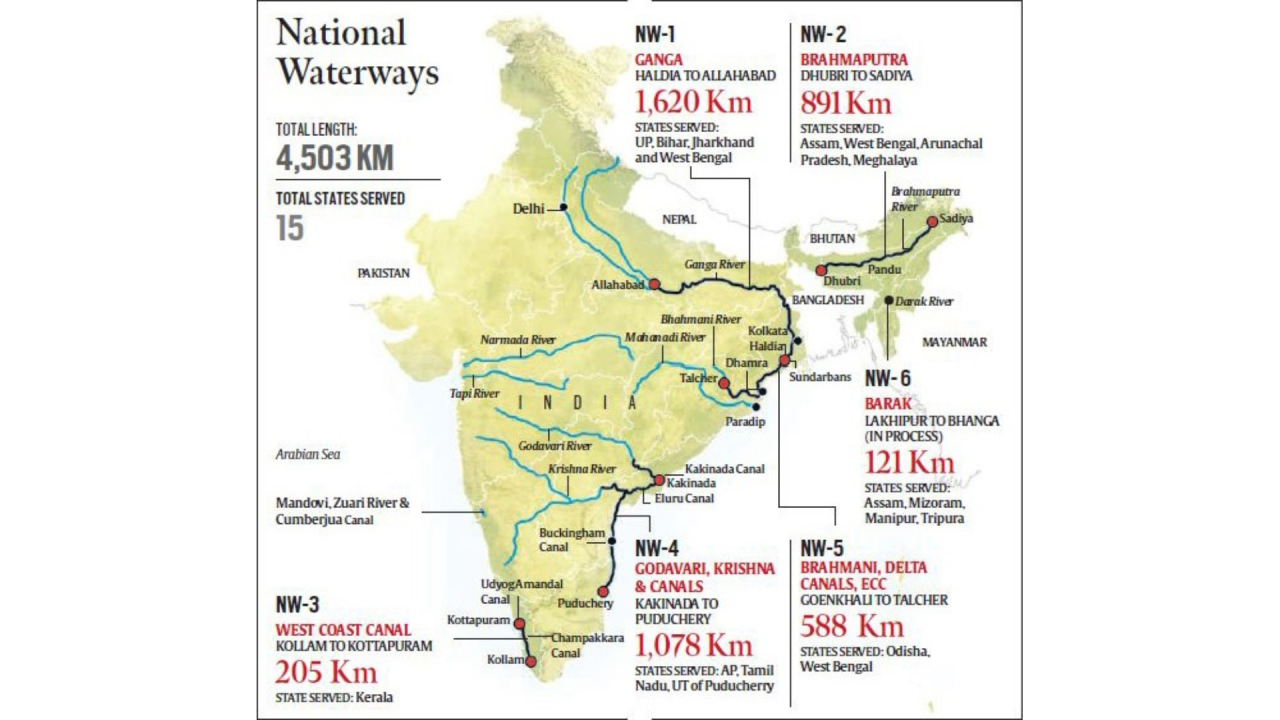-
21 Jan 2025
GS Paper 1
Geography
Day 44: How can inland waterways transform India’s logistics and transportation sector in terms of economic growth, environmental sustainability, and what are the key challenges and opportunities in their development? (250 Words)
Approach
- Introduce by mentioning the transformative potential of inland waterways in logistics.
- Highlight economic and environmental benefits.
- Analyze challenges and suggest opportunities.
- Conclude suitably.
Introduction
India, with over 14,500 km of navigable waterways, has immense potential to utilize inland waterways as a sustainable and cost-efficient mode of transport. Policies like the National Waterways Act, 2016, which established 111 national waterways, and the Sagarmala Project aim to capitalize on this underutilized resource.
Body
Economic Growth through Inland Waterways:
- Cost-effective Transport: Inland water transport (IWT) is up to 60% cheaper than road transport and 40% cheaper than rail, especially for bulk commodities like coal, cement, and iron ore.
- Boost to Domestic and International Trade: Waterways such as National Waterway-1 (NW-1) connect industrial hubs like Varanasi to ports like Haldia, facilitating seamless trade.
- The Indo-Bangladesh Protocol on Inland Water Transit and Trade enables cross-border cargo movement, enhancing regional trade.
- Reduction in Logistics Costs: With logistics accounting for nearly 14% of GDP, shifting to waterways can reduce the burden on road and rail, making Indian goods more competitive globally.
- Employment Generation: Development of terminals, ports, and allied infrastructure creates job opportunities. For instance, multimodal terminals under the Jal Marg Vikas Project on NW-1 have boosted regional development.
Environmental Sustainability:
- Reduced Carbon Footprint: Inland water transport emits 50-75% fewer greenhouse gases compared to road transport.
- Energy Efficiency: A litre of fuel can move one ton of cargo for 24 km on road, 85 km on rail, and 105 km on water, making waterways the most fuel-efficient.
- Mitigating Urban Congestion: Diverting cargo from roads and rail to waterways can alleviate urban pollution and congestion, as seen in Kolkata and Guwahati.
Challenges in Utilizing Inland Waterways:
- Infrastructure Deficits: Insufficient terminals, dredging facilities, and multimodal connectivity hinder seamless operations.
- For example, the Brahmaputra (NW-2) faces challenges with siltation and shallow navigation depths.
- Seasonal Constraints: Low water levels during dry seasons (specially in peninsular rivers) and flooding during monsoons restrict year-round navigation.
- Environmental Impacts: While generally eco-friendly, waterway development can affect riverine ecosystems, necessitating careful planning.
Opportunities and Policy Support:
- Multimodal Integration: Integrating IWT with rail and road networks, as envisioned under the Sagarmala Project, can enhance supply chain efficiency.
- Policy Frameworks: The Jal Marg Vikas Project has improved navigability on NW-1 with financial aid from the World Bank.
- The Inland Vessels Act, 2021 modernizes regulations, ensuring ease of operations.
- Technology Adoption: Using modern dredging techniques and eco-friendly vessels can minimize environmental concerns.
- Private Sector Participation: Public-private partnerships (PPPs) for developing ports and vessels can accelerate growth.
Examples:
- National Waterway-3 (NW-3): Connects industrial regions in Kerala, with cargo movement rising by 90.44% between 2021-22 and 2022-23.
- Arth Ganga Concept: Promotes economic activities along NW-1, integrating rural areas into the supply chain.
Conclusion
Inland waterways offer a transformative solution for India’s logistics and transportation sector, balancing economic growth with environmental sustainability. Addressing challenges through robust infrastructure, policy support, and public-private collaboration can unlock their full potential, making IWT a cornerstone of India’s future transportation landscape.





